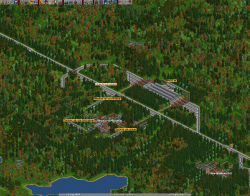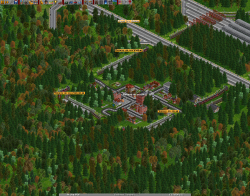Sandbox up again
Hello,
the Sandbox is now working again (at revision 9392). Join in and enjoy newhouses!
Hello,
the Sandbox is now working again (at revision 9392). Join in and enjoy newhouses!
Hello community,
currently, a bug keeps us from joining our Sandbox Server. The bug was introduced some nightlies ago but today’s nightly will fix it again. So stand by for more nightly action starting today, 19.00 GMT!
Well, what I bring up tonight is an observation I made while playing on the Sandbox Server last evening. First to say, most people playing the past game may have experienced both sickness and dizziness. This *may* be due to the circumstance that the played scenery was toyland. But in the end the game had a great network, with many nice hubs, exits, entries and all the usual stuff you like in our games. Later on, I found this interesting “feature” implemented to the Toy/Cola exit:
Greetings, readers.
This post is dedicated to the baddies of #OpenTTDCoop, the 2*45 curves and realism.
Oh, the 2*45. OMG’d over whenever spotted, as you might expect.
Sometimes those slip by with no one really noticing, and we have a great example of that.
 If you can’t see those baddies there, no problem. I have prepared a more clarified example, which obviously is the same area but with transparent buildings and trees enabled.
If you can’t see those baddies there, no problem. I have prepared a more clarified example, which obviously is the same area but with transparent buildings and trees enabled.
Those poor people must have pretty noisy environment with all those trains, albeit slow, going around and around. Slow, you ask? Yes, due to those 2*45 curves mentioned earlier. The other reason agains 2*45 curves is that they are totally not realistic. (Most) Real trains just can’t bend around themselves in such a small area (3×3 tiles in OTTD).
 Speaking of realism, OTTD sure does hate it, given the above example and the fact that one train holds ONE THOUSAND passengers while a station, no matter how huge, holds a mere
Speaking of realism, OTTD sure does hate it, given the above example and the fact that one train holds ONE THOUSAND passengers while a station, no matter how huge, holds a mere
four thousand. We at #openttdcoop obviously love it, and it makes some amusing contradictions. Gameplay is greater than realism, it seems.
The bridges at the right are a very good example of this. Our goal was to have it realistic, as real Shinkansen rail have loads of bridges and tunnels. I doubt it has double double-rail bridges per direction though. My solution to that would have been a landbridge, due to not looking like arse and not needing doubling for signal blocks. We could have pretended that the landbridges were actual long and large bridges, but no, no landbridges
because the Japanese don’t make those! Fine enough, I didn’t need to build those bridges.
 Oh, and for general hackiness, let’s have a look at some of our.. renovated sideline hubs (SLHs).
Oh, and for general hackiness, let’s have a look at some of our.. renovated sideline hubs (SLHs).
It was originally a T-shaped hub, one branch from the trunk line. Later we decided it wasn’t enough, and needed two branches from the trunk line here, one to each direction. It isn’t that bad really.. Note that the Shinkansen tracks and trains allow for full speed with two-tile curves.
Rebuilding existing SLHs can be done in many ways, from just hacking up that extra entry and exit to major rebuilding and refitting. Another example (by yours truly). Other somewhat amusing SLHs have been built in this game too. I mentioned earlier that the Shinkansen set allows for 2-tile curves.. well, you have a very elaborate example too.
Oh, and if you got all excited about this, don’t hold your breath. I’m not committed to daily or weekly updates 🙂
note: popularity might change my attitude though

Menway-on-sea is a small town, a sleeping beauty in the deep forests of the nation. In the year 1965, this situation suddenly changed: executives of the grand national rail company “Kasimasi Transports” decided to connect the town to the newly invented Shinkhansen Network, a highspeed train network for passenger transport only.

As you may imagine, local authorities were not amused about Kasimasi Transports’ proposal. Both sides agreed on a clause about noise barriers, afforestation and environmental efforts carried out by the train company. As you may see on this aerial photo, Menway-on-sea received both a highly efficient commuter system and a link to the nationwide high-speed-train network.